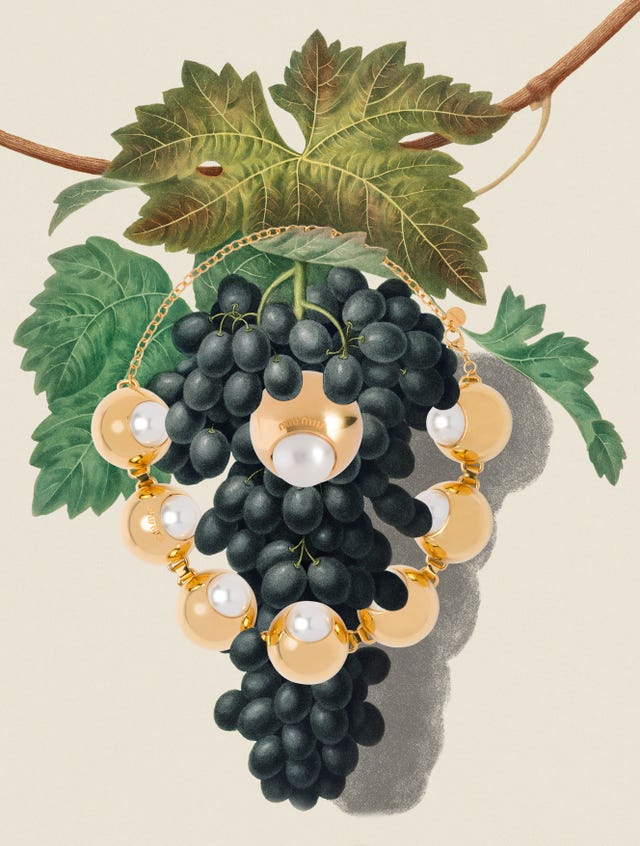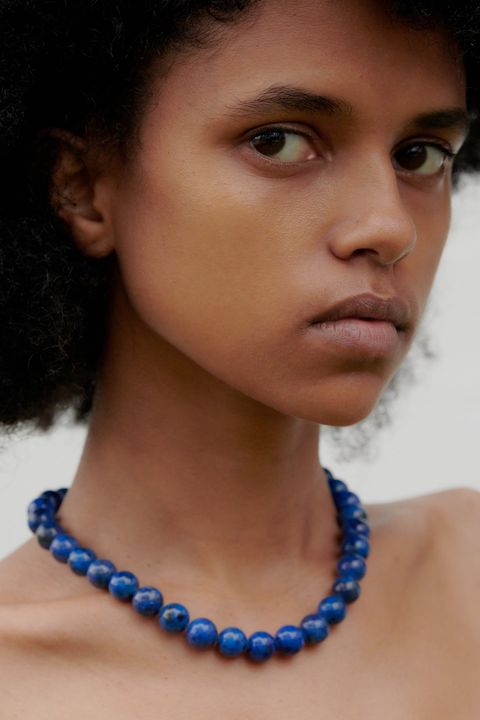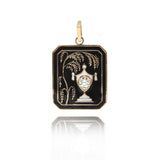
Anna Bu Kliewer/Jewelry by Miu Miu
Back in 2010, the jeweler Irene Neuwirth convinced her Australian opal dealer to cut some of the gemstones for stringing as a casual but fine necklace. He’d thought it was “ridiculous” to bore holes into such costly gems, but she’s still wearing that piece. Opal strands, hand-knotted on silk, were hardly flying off the shelves when Neuwirth started designing hers. But “at the moment, they seem to be selling everywhere,” she says. It isn’t only opals: There’s a trend afoot for beaded necklaces of all types, many of them silk-strung with earthy-but-ritzy semiprecious stones. (Neuwirth’s Beaded Candy line features uninterrupted strands of lapis lazuli, labradorite, turquoise, chrysoprase, and other stones.)
The resurgence of these pieces can be chalked up to the rise of all things grandmillennial, the traditionalist-inspired aesthetic that has us digging plissé lampshades—and digging through Grandma’s jewelry box, too. But the trend is about far more than just nostalgia: It’s a form of memorialization. That is the superpower of jewelry: to tether us to those we treasure, especially in the face of distance or loss.
For jewelers, business has been brisk during the pandemic, as people have sought, well, a lot of critical things from places of isolation and despair—among them, some sense of permanence and connection. We have been craving the colors (and, perhaps, the healing powers) of gemstones, aching for talismans—heirlooms, or future ones, at least.
For all those reasons, Laurel Pantin and Victoria Lampley founded their consultancy The Stax last spring. The two function like art advisers in the jewelry world. After losing her mother, Lampley made a habit of always wearing some of her jewels, and she and Pantin wanted to help their clients reset inherited pieces to their taste, as well as acquire new items with meaning. (Fine jeweler Isabel Borland, likewise, has been restringing a lot of necklaces passed on to clients, often leavening their fussy pearls with stretches of opal and moonstone.) Now, Pantin says, “When I am buying things, I think, ‘Am I going to wear this every day?’ When [my kids] inherit it from me, I want them to look at it and say, ‘Mom wore this every day.’”
They’re not the only ones looking at the present from the vantage point of the future. “I relate much more to the way 70-year-olds dress than the way 30-year-olds do,” says Sophie Buhai, who offers hand-knotted gumball collars in onyx, jade, lapis lazuli, and pearl. Borland strings amazonite, blue chalcedony, carnelian, and malachite on silk or neon-pink nylon thread, with clasps hand-carved in wax and then cast in 18-karat gold. “Wearing Granny’s beads with Mom’s jeans and Dad’s blazer” has never been more popular, per stylist and Bridesmaids co–costume designer Leesa Evans. When she wants to conjure that old-school élan, she turns to a malachite strand that had belonged to her own grandmother.
In 2019, The Row co-founder Danielle Sherman relaunched her family’s tailoring business as the fine jewelry brand Sherman Field. Inspired by deeply researched offerings from the ’40s and, in particular, a ’70s Cartier lighter of her dad’s, she wants her work to feel “like heritage jewelry, something that can remember and reference the past.” Last spring, she introduced lockets: heavy, handsome whoppers (in her house 18-karat gold) faced with barre or pyramid shapes, or with retro-tone stones such as tiger’s eye, lapis lazuli, jade, mustard chalcedony, and pink moonstone. Because the studio offers photo assembly, she’s seen piece after piece filled with beloveds. Lockets, of course, are the most sentimental of talismans, and Sherman keeps a snapshot of her late father in one.
After jeweler Ashley Zhang’s dad passed away, she bought a fragile gold “in memoriam” pendant dating back to the reign of Queen Victoria. The queen plunged court and country into extended mourning when her husband, Prince Albert, died in 1861, and boosted a mania for grief jewelry fashioned from the matte black gemstone called Whitby jet. (Hence “jet black.”) Zhang wore her antique for weeks before deciding to re-create it with an updated shape; in October, she dropped a modern mourning collection that remixes the Georgian epoch’s black-and-white enameling with the Victorian era’s urn and weeping willow motifs. New fine jewelry lines tend not to take off right away—plus, Zhang hadn’t really teased it—but “as soon as we launched, we had orders coming in,” she says. “I just feel like it speaks to the need out there.”
I myself had immediately fixated on period mourning jewelry after my little brother died across the ocean in 2020. There were impearled forget-me-not lockets (the pearls symbolized tears); teddy bear lavalieres, carved from jet for bereft mothers; rings etched with names and dates; brooches that held snips of hair. In the end, it was an Isabel Borland signet pinky ring for me, hand-carved in wax and cast in gold, and it never comes off.
This article appears in the April 2022 issue of ELLE.
This content is created and maintained by a third party, and imported onto this page to help users provide their email addresses. You may be able to find more information about this and similar content at piano.io


